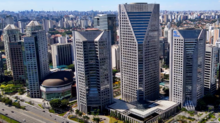Portal:Business
The Business and Economics Portal Business is the practice of making one's living or making money by producing or buying and selling products (such as goods and services). It is an activity or enterprise entered into for profit." A business entity is not necessarily separate from the owner and the creditors can hold the owner liable for debts the business has acquired. The taxation system for businesses is different from that of the corporates. A business structure does not allow for corporate tax rates. The proprietor is personally taxed on all income from the business. A distinction is made in law and public offices between the term business and a company such as a corporation or cooperative. Colloquially, the terms are used interchangeably. (Full article...) Economics (/ˌɛkəˈnɒmɪks, ˌiːkə-/) is a social science that studies the production, distribution, and consumption of goods and services. Economics focuses on the behaviour and interactions of economic agents and how economies work. Microeconomics analyses what is viewed as basic elements within economies, including individual agents and markets, their interactions, and the outcomes of interactions. Individual agents may include, for example, households, firms, buyers, and sellers. Macroeconomics analyses economies as systems where production, distribution, consumption, savings, and investment expenditure interact, and factors affecting it: factors of production, such as labour, capital, land, and enterprise, inflation, economic growth, and public policies that have impact on these elements. It also seeks to analyse and describe the global economy. (Full article...) Selected article
A Bank run (also known as a run on the bank) is a type of financial crisis. It is a panic which occurs when a large number of customers of a bank fear it is insolvent and withdraw their deposits.
 A run on the bank begins when the public begins to suspect that a bank may become insolvent. As a result, individuals begin to withdraw their savings. This action can destabilize the bank to the point where it may in fact become insolvent. Banks retain only a fraction of their deposits as cash (see fractional-reserve banking): the remainder is issued as loans. As a result, no bank has enough reserves on hand to cope with more than the fraction of deposits being taken out at once, and will 'call in' the short term deposits itself has made. This can cause a shortage of Market liquidity in the short term money market. As a bank run progresses, it generates its own momentum. As more people withdraw their deposits, the likelihood of default increases, so other individuals have more incentive to withdraw their own deposits. If many or most banks were to suffer runs at the same time, then the resulting chain of bankruptcies can cause a long economic recession. To prevent bank runs, Central banks can prevent financial institutions from failing by:
Selected image
Selected economyThe economy of South America comprises approximately 434 million people living in the 12 sovereign states and three dependent territories of South America, which encompasses 6 percent of the world's population. South America ranks fifth in terms of nominal GDP by continent, behind North America and after Oceania. South America has two major trade blocks: Mercosur and the Andean Community. Brazil is the largest economy in South America in terms of Nominal GDP, it has a vast and diverse economic landscape encompassing agriculture, manufacturing, services, and natural resources. Due to Brazil's major economy, it has a large influence over its neighbors, and even globally. Argentina which is South America's second largest economy, boasts a rich history of industrialization and a well-developed agricultural sector. Despite economic challenges and very high inflation, Argentina uses its abundant natural resources and skilled workforce to drive economic growth and innovation. Together, Brazil and Argentina serve as economic powerhouses and as such, are major influences to surrounding countries. Uruguay stands out as it boasts the highest GDP per capita in the region. Renowned for its stable political environment, strong social welfare system, and diversified economy, Uruguay has consistently ranked among the top nations in terms of human development and standard of living. Uruguay has a large agriculture sector and has made previous strategic investments in technology and innovation, Uruguay's economy thrives on both domestic consumption and international trade. Guyana ranks second which is attributed to its oil and gas sector. (Full article...) Selected quote"At Toyota, we began to think about how to install an autonomic nervous system in our own rapidly growing business organization. In our production plant, an autonomic nerve means making judgments autonomously at the lowest possible level; for example, when to stop production, what sequence to follow in making parts, or when overtime is necessary to produce the required amount. These discussions can be made by factory workers themselves, without having to consult the production control or engineering departments that correspond to the brain in the human body. The plant should be a place where such judgments can be made by workers autonomously. In Toyota's case, I believe this autonomic nervous system grew as the idea of just-in-time penetrated broadly and deeply into the production field, and as adherence to the rules increased through the use of kanban. As I thought about the business organization and the autonomic nerves in the human body, the concept began to interconnect, overlap, and stir my imagination."
TopicsRelated WikiProjectsDid you know (auto-generated) -
On this day in business history
General imagesThe following are images from various business-related articles on Wikipedia.
More did you know
Business news
SubcategoriesRelated portals
Things you can doUrgent and important articles are bold
WikimediaThe following Wikimedia Foundation sister projects provide more on this subject:
SourcesDiscover Wikipedia using portals |







































